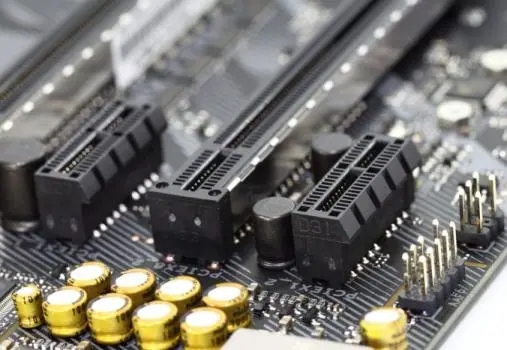Home > News > Industry News
一、 Nowadays, PCI-E slots have become the main expansion slots on motherboards. What is the purpose of mainly focusing on PCI-E x1/x4/x8/x16?
The specific function is:
1. The graphics card will use PCI-E slots. PCI-E 3.0 x16 can meet the needs of any high-performance graphics card.
2. Hardware such as independent sound cards, independent network cards, USB 3.0/3.1 interface expansion cards, RAID array cards, PCI-E SSDs, mSATA SSDs, m.2 SSDs, M.2 wireless network cards, or other M.2 interface devices can all be plugged into PCI-E slots. Therefore, manufacturers will install enough PCI-E slots for them to ensure the expansion capability of their products and meet the needs of players, such as for mining or achieving multi screen output.

二、 What are the differences between the four mainstream PCI-E slots PCI-E x1/x4/x8/x16 on motherboards now?
1. The PCI-E x16 slot has a total length of 89mm and 164 pins. There is a slot on the outer side of the motherboard, which divides the 16x into two groups: front and rear. The shorter slot has 22 pins and is mainly used for power supply, while the longer slot has 142 pins and is mainly used for data transmission. It has the high bandwidth brought by 16 channels.
PCI-E x16 slot, mainly used for graphics cards and RAID array cards, etc. This slot has excellent compatibility and can be down compatible with x1/x4/x8 level devices. It can be said that the PCI-E x16 slot is a universal slot for PCI-E. Due to the PCI-E x16 slot being commonly used for graphics cards, it is directly connected to the CPU processor and physically located close to the CPU. This reduces latency in data exchange between the graphics card and processor, allowing the system's performance to be fully utilized.
2. The PCI-E x8 slot has a total length of 56mm and 98 pins. Compared with PCI-E x16, the main difference is that the data pins have been reduced to 76, and the short power pins are still 22.
For compatibility, PCI-E x8 slots are usually processed in the form of PCI-E x16 slots, but only half of the data pins are valid, which means the actual bandwidth is only half of the true PCI-E x16 slot. You can observe the motherboard wiring, and there is no wiring connection in the latter half of x8, and even the pins are not soldered.
In fact, except for flagship motherboards that can provide multiple true PCI-E x16 slots, mainstream motherboards only provide one true PCI-E x16 slot, which is the one closest to the CPU. The second and third PCI-E x16 slots are mostly PCI-E x8 or even x4 level.
3. The length of the PCI-E x4 slot is 39mm, which is also implemented on the basis of the PCI-E x16 slot by reducing data pins. It is mainly used for PCI-E SSD solid state drives or M.2 SSD solid state drives installed through PCI-E adapter cards. The PCI-E x4 slot is usually extended from the motherboard chip, but with the increase in the number of PCI-E channels inside the CPU, some high-end motherboards can now provide PCI-E x4 slots directly connected to the CPU for installing PCI-E SSD solid-state drives.
Why can't I find the PCI-E x4 slot on the motherboard? In fact, it appears in the form of an M.2 interface.
However, like the PCI-E x8 slot, the PCI-E x4 slot is now mostly designed as a PCI-E x16 slot for compatibility, or expanded to an M.2 interface for installing M.2 SSDs, M.2 wireless network cards, or other M.2 interface devices, while other expansion cards are reserved for the PCI-E x1 slot.
4. The length of the PCI-E x1 slot is the shortest, only 25mm, and compared to the PCI-E x16 slot, its data pins are significantly reduced to 14. The bandwidth of PCI-E x1 slot is usually provided by the motherboard chip, mainly used for independent network cards, independent sound cards, USB 3.0/3.1 expansion cards, etc. PCI-E x1 slot can even be used to install graphics cards into PCI-E x1 slot through adapter cables for mining or multi screen output. X1 is used to replace the original PCI device.
三、 What are the differences in appearance between PCI-E x1/x4/x8/x16 slots?
There are generally four lengths of PCIE slots on the motherboard, the shortest being 1X, slightly shorter than PCI being 4X, 8x being longer than 4x, and the longest being 16X. However, these are only physical interfaces.
In order to ensure compatibility between long and short slots (physical length compatibility, version compatibility including 1.0, 2.0, 3.0 compatibility), short slots can naturally be inserted into long slots, but it is not easy to insert long slots into short slots. Generally, X1 still maintains its original length, while x4, x8, and x16 are all uniformly sized to x16 in actual motherboards. It's just a difference in speed. The extra feet are suspended and useless. This way, the appearance will be uniformly compatible. Carefully check if the pins are soldered to the circuit. Generally, the motherboard indicates how much PCI-E x it is.
Embedded motherboard is generally understood as the CPU board embedded in the device for contro...
Both industrial control computers and computers belong to the category of computers, and their m...
X86 embedded motherboard is a type of embedded motherboard, characterized by its small size and...
Shenzhen VKoming Technology CO.,Ltd.
Phone: 13612966567
Tel: 0755-28196692
Email: lyp@micipc.com
Address: 508, Building 8, Evergrande Fashion Valley Building, Fulong Road, Henglang Community, Dalang Street, Longhua District, Shenzhen City